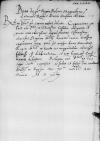Letter #2764
Bona Sforza to Ioannes DANTISCUSBrest-Litovsk, 1544-10-11
| received Wormditt (Orneta), 1544-10-21 Manuscript sources:
| ||||
Text & apparatus & commentaryPlain textText & commentaryText & apparatus
Reverendo in Christo Patri, domino
Reverende in Christo Pater, sincere nobis dilecte.
Cognovimus ex litteris Vestrae Paternitatis et
Ac salva et felix diu valeat.
Datae
in

